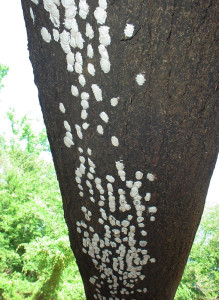
Dobsonfly eggs on underside of log on the Neches River in east Texas. Photo by Joe Pace, Texas Forest Service. Taken 5 June, 2010.
Imagine you’re floating idyllically down a Texas river. You have to duck slightly to pass under a big tree growing nearly horizontally over the water. Suddenly you notice a bunch of strange white patches, like chewing gum stuck all over the bottom of the tree trunk. What is it?
Such was the experience of Texas Forest Service entomologist Joe Pase recently on the Neches River in east Texas. He snapped the photo you see here. He and I were both puzzled as to its identity, though it definitely looked “insect”. Leave it to Ed Riley at the A&M entomology museum to know the answer.
Give up? It’s the Texas dobsonfly, Corydalus texanus Banks. One of the true prize catches for a 4-H insect collection, the Dobsonfly is one of our largest aquatic insects. If you’re a canoeist, and are sharp-eyed enough to spot Corydalus egg cases, you can be sure that your stream’s water quality is on the good side. The immature stages of the Dobsonfly, called hellgramites, live only in relatively clean, well-oxygenated water. To see more pictures and information about this cool insect, click here.
